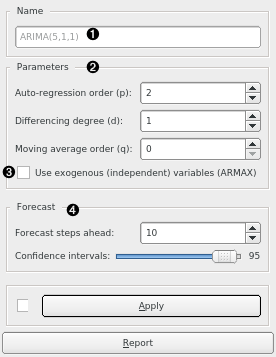ARIMA Model
Model the time series using ARMA, ARIMA, or ARIMAX model.
Inputs
- Time series: Time series as output by As Timeseries widget.
- Exogenous data: Time series of additional independent variables that can be used in an ARIMAX model.
Outputs
- Time series model: The ARIMA model fitted to input time series.
- Forecast: The forecast time series.
- Fitted values: The values that the model was actually fitted to, equals to original values - residuals.
- Residuals: The errors the model made at each step.
Using this widget, you can model the time series with ARIMA model.

- Model's name. By default, the name is derived from the model and its parameters.
- ARIMA's p, d, q parameters.
- Use exogenous data. Using this option, you need to connect additional series on the Exogenous data input signal.
- Number of forecast steps the model should output, along with the desired confidence intervals values at each step.
Example
